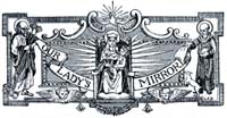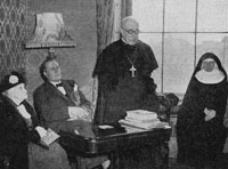

1926 1927 1928 1929 1930 1931 1932 1933
1934 1935 1936 1937 1938 1939 1940 1941
1942 1943 1944 1945 1946 1947 1948 1949
1950 1951 1952 1953 1954 1955 1956 1957 1958 1959
Our Lady's Mirror
Summer 1952

Fr Fynes-Clinton’s
jubilee
After the Sung Mass on the feast of the Visitation of Our Lady, the Administrator proceeded to the
altar of the Ascension (the chapel of the Church Union) and blessed the picture of Our Lady and the Holy
Child painted by Giovanni Antonio Bazzi (Sodoma) – which was given by Mrs Brackley some time back as
an altar piece for the proposed memorial chapel to be built if and when the north walk of the Cloister is
put up. As this extension seems to be somewhat remote at present, it was decided to hang the picture in
the Shrine Church, and so it has found a temporary resting place over the altar of S.S. Francis and Clare
(i.e. chapel of the Ascension). For several months the painting has been in a London studio undergoing
expert cleaning. It is a magnificent work of art. Unfortunately the present position is not the best one
could have wished to show it in, in all the glory of its colour, but it will help us to arrange the lighting in
the most perfect way possible when the Cloister Chapel is put up. The picture came from the famous
Mond collection. The artist lived between 1477 and 1549; what history was being made during that
period in church and State, not only in England but all over Europe!
A much-needed addition has been made to the sacristy by the fixture of a new section to the vestment
press. There are eventually to be five bays, three only of which have so far been given. While we are on
the subject of vestment presses – it seems incredible perhaps – but we are badly in need of more low
mass sets, especially for the Holy House and High Altar. Many, indeed most, of those that have been
given were secondhand to start with, and the constant use they are put to is obvious. Also we are very
badly off for copes, the one we usually use for pilgrimages is past repair, and the one we use for regular
services will soon have to be replaced. Our servers’ cassocks, also originally secondhand, are in a
disgraceful state as well as the cottas. The Shrine is not in the position to replace any of these things
from its funds, so will our readers please see what can be done about it. N.B. – Vestments, etc., given to
particular chapels may not be used elsewhere. Donors expect their gifts, naturally, to be kept for and
used in the chapels to which they are donated.
The second section of stalls has been put it, this being the first on the Gospel side of the choir. It is a
wonderful improvement to the church. These are the stalls of the Guardians. Eight more are required to
complete the set.
By the will of Major Bowker a fine memorial brass has been let into the floor of S. Thomas’s chapel in
memory of Father Wilmott-Phillips, the late Vicar of Plaxtol. This chapel built and furnished by Bowker is
a chantry for Father Tooth, Wilmott-Phillips and himself; a window depicting S. Thomas (of Canterbury)
is in course of being made by Sir Ninian Comper, and we hope it will be in place during the “fall” as our
cousins from overseas would say.
At the end of July the annual Oxford Pilgrimage, organised at S. Paul’s, made its twenty-fifth visit to the
Shrine; this has not been consecutive, as of necessity there was a break during the war. Well done, S.
Paul’s, Oxford.
The Altar pavilion used at Hickleton for the Congress there some years back and subsequently given to
the Shrine by the late Lord Halifax has been undergoing a good clean up and repainting, and not before
it was needed. It is a nice design and fits into the garden surround well. It is of great use too, when
really large pilgrimages of several thousand people come, and overflow Masses have been sung there on
such occasions.
Many of us remember the piscina in the lower garden which twenty years ago was used for sprinkling
the sick with the water pumped from the Holy Well in the pilgrimage Church. For a long time now it has
not been used, and all sprinkling has been done at the well itself – so William had filled it with chalk-free
soil and hopes to grow a clump of rhododendron and similar plants there. If successful it should be a
great attraction to this part of the grounds as we cannot grow that type of plant elsewhere.
A reader of the Mirror writes to complain that we are getting too much like an antiquaries journal, while
in his opinion the paper ought to be used more for the propagation of the faith. Our reply is yes, but if
this is to be done then it is up to our subscribers to write and send in articles for the Editor’s
consideration. We keep on asking for copy for the Mirror but get very little literary support. So it is just
up to our readers. We are more than grateful to those who do send in articles and so have enabled us to
publish this paper for the last twenty-six years without a break, the first number having gone out in
January, 1926.
TO THE EDITOR OF THE MIRROR
Dear Father
Once again I have received my copy of the Mirror. I find myself wondering what it proposes to do. A
quarterly paper of this sort will, of course, give us the news of all the happenings connected with the
Holy House and Walsingham itself. This I believe you succeed in doing admirably. But the rest . . . . One
might be reading an Archaeological Journal. In number after number we are given pages of stuff such as
cover page 13. It may be intensely interesting to the specialist that the “ten bougets of silver” (whatever
they are) were given by Alice Tye and that they weighed “1½ ounces with the strings”, but frankly I
cannot see that this sort of thing will appeal to the average Catholic be he priest or layman.
We pray for the day when all England shall be truly called “ Our Lady’s Dowry” once more. Cannot you
use the Mirror in this cause? I fear it is becoming the happy hunting ground of medieval dreamers
instead of a means of spreading the living Catholic Faith.
Yours sincerely,
B.M. OMAN
St. Barnabas
Tunbridge Wells.
Vide Editor’s reply in Notes.
A PRIEST FOR EVER
It was a bright May morning, and as we drove up and entered the beautiful Church of St. Magnus by
London Bridge one was struck by the peacefulness of the spot in the heart of the great city. This 17th
century church, built by Sir Christopher Wren, which stands upon the ancient foundations of a pre-
Norman church, is one of the most interesting of all the ecclesiastical edifices of the city. The occasion
was the jubilee of the Reverend Henry Joy Fynes-Clinton, and the High Mass, which began at 11 o’clock,
was celebrated by him. The service was a most beautiful and impressive sight and the singing and organ
a treat to hear. One could not help wondering what had happened to the rest of the Church of England!
Among those in the choir was the Rt. Rev. The Archimandrite Nicholas Gibbes.
Father Hope Patten, who was the preacher, commented among other things on the three outstanding
features of Father Fynes-Clinton’s ministry – the great work which he had done, and indeed still does for
Catholic reunion, a work which is so misunderstood by many and for which he has been so persecuted:
his founding of the Society of the Precious Blood for Priests, a work so dear to the heart of S. Charles
Borromeo their patron: and his great devotion to Our Lady. Especially was he a devoted client of Our
Lady of Walsingham and had been so from the first beginning of the revival of the Shrine. At the end of
High Mass the members of the Guild of Our Lady Salve Regina went in procession to the Shrine of Our
Lady of Walsingham where the Easter Anthem was sung.
A luncheon followed in the Fishmongers’ Hall where presentations were made to Father Fynes-Clinton –
and so ended a memorable, and perhaps unforgettable occasion.
S.S.
articles: D T Glassford, 'The Assumption' (a poem); 'Two Maltese Shrines of Our Lady'; J C S, 'Our Lady
of the Holy Mountain'; Lionel S Lewis, 'The Cup of Nanteos: Cwpwn Nanteos'
photographs: two photographs from Fr Fynes-Clinton's jubilee [one above]; four photographs of the
Maltese shrines; two photographs of monasteries on the Holy Mountain; an icon of Our Lady of the Gate
in the Shrine church; the Shrine in the parish church in 1931